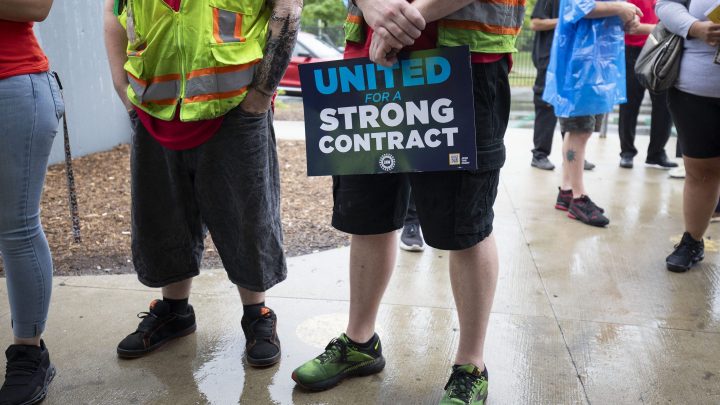
What’s behind the UAW’s demand for a 40% worker raise?

Union workers at GM, Ford and Stellantis are hoping to win a 40% pay raise in their next contract.
Negotiations are underway and leaders of the United Auto Workers union are coming out swinging as they seek higher pay, shorter hours and better benefits. And they’re being vocal about it all.
It hasn’t always been this way though; the last UAW contract signed in 2019 included two 3% wage hikes. So what’s changed?
UAW President Shawn Fain said there’s a clear reason to push for a big increase in a new contract for autoworkers. He spoke to workers last week in a livestream address.
“We have to work longer and harder just to maintain the same standard of living we had before,” he said.
So that’s why the UAW is seeking a 40% wage increase over the course of the union’s next contract. Which seems like a lot, right?
“Well, in normal times, yes, it would sound like a huge raise and it would sound like an unrealistic expectation,” said Art Wheaton of Cornell University’s School of Industrial and Labor Relations.
But these are not normal times, he said: Inflation has been high, the labor market is still tight, and unions in other industries have negotiated sizable wage increases this summer, like United Airlines pilots and UPS workers.
Plus, Wheaton said that unions are well-liked right now, citing a Gallup poll from last year. “The general public has over a 71% favorability of unions.”
Combine those factors with strong profits for carmakers, and the UAW and unions more generally are in a rare position of bargaining strength, according to Anne Lofaso, a law professor at West Virginia University.
“Most of the time, the union is not in a good position,” she said. “Most of the time, they’re not going to have all these factors for them.”
So, she said, it makes sense for the union to come into these negotiations with high demands, but that they’ll likely settle for less.
“This is not their bottom line, I’m sure,” Lofaso said. “This is aspirational.”
And automakers are pushing back. In a statement, GM said the UAW’s demands would “threaten our ability to do what’s right for the long-term benefit of the team.”
So expect a lot more back and forth before the contract deadline next month.
There’s a lot happening in the world. Through it all, Marketplace is here for you.
You rely on Marketplace to break down the world’s events and tell you how it affects you in a fact-based, approachable way. We rely on your financial support to keep making that possible.
Your donation today powers the independent journalism that you rely on. For just $5/month, you can help sustain Marketplace so we can keep reporting on the things that matter to you.











